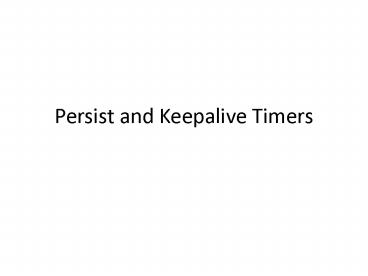Persist and Keepalive Timers - PowerPoint PPT Presentation
1 / 12
Title:
Persist and Keepalive Timers
Description:
TCP could stall. Solution: Send periodic probes to elicit ACKs from receiver ... Persist timer probes are sent at intervals based on the RTO ... – PowerPoint PPT presentation
Number of Views:484
Avg rating:3.0/5.0
Title: Persist and Keepalive Timers
1
Persist and Keepalive Timers
2
Window Advertisement
- What happens when a window advertisement with
recvwin gt 0 is lost? - ACKs are not retransmitted
- TCP could stall
- Solution
- Send periodic probes to elicit ACKs from receiver
3
Persist Timer in Action
- Why 1 byte is sent?
- Persist timer probes are sent at intervals based
on the RTO - But it is at least 5 sec and at most 60 sec
- TCP never gives up sending persist timer probes
unless - Window opens up
- Application terminates
4
Silly Window Syndrome
- Window based flow control schemes may suffer from
silly window syndrome - Receiver side
- Receiver advertises small window and sender sends
small chunk of data - Sender side
- Sender sends small amount of data instead of
waiting for more data
5
Receiver Side Avoidance of SWS
- Do not send a new window update unless it is
larger than current window by - 1 MSS
- Or, half of receivers buffer space, whichever is
smaller (rare)
6
Receiver AvoidanceSWS
- Notice persist timer in action
- Although bytes are being received, win is still
0. Why?
7
?
- Why 1022 bytes are not advertised?
- Why 509 bytes are advertised?
8
Sender Side Avoidance of SWS
- Do not transmit data unless
- A full-size segment can be sent
- Or, we can send at least half of the window that
the other side has ever advertised (older,
primitive hosts) - Or, we can send everything we have and either we
are not expecting an ACK or Nagles algorithm is
disabled
9
Keepalive Timer
- Send packets every 2 hours to check if client is
up - If no activity from client, four possibilities
- Client is up
- Client is down
- Client has crashed and rebooted
- Client unreachable (similar to scenario 2)
10
Host has crashed
- If no response, send 10 probe packets 75 seconds
apart, before declaring the connection dead
11
Host has crashed and rebooted
- TCP reset is useful
12
Host unreachable
- ICMP host unreachable messages are ignored by TCP
- TCP returns error of No route to host to the
application































